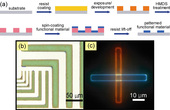Highlight
Orthogonal Processing of Flexible Electronics
Achievement/Results
Using environmentally friendly supercritical carbon dioxide and a new calixarene-based molecular glass photoresist, NSF-funded researchers at Cornell University have invented a new process that could revolutionize the way organic electronics are produced. The research groups of George Malliaras (Cornell) and Christopher Ober (Cornell) and IGERT Trainee Priscilla Taylor have collaborated on this discovery. Organic semiconductors, like silicon, are materials that can be used to make electronic circuits, sensors or solar cells. And unlike silicon they can be processed from solution like an ink or paint. However, when complex, multilayer devices are being produced this very processibility works against an organic semiconductor and mixing of different layers can take place to reduce device performance. As a result many desirable devices cannot even be made using these materials. Instead, this new discovery of orthogonal processing overcomes these problems and will enable processing of complex organic electronic devices without these undesirable side effects. Orthogonal processing will be especially important for the production of many of the devices planned for the FlexEBio IGERT since biomacromolecules can also be processed using these new methods. Fundamental studies of the details of the patterning process are underway.
Address Goals
This new development is very important in this internationally competitive field of flexible organic electronics which will enable our group and others to design new devices, that do date have been not previously possible. Flexible or “rollable” electronics is a “disruptive” technology, that is, one with the potential to completely revolutionize or create entire industries. Flexible electronics will grow into a multibillion-dollar industry over the next decade and transform to an unprecedented degree our view of electronics and how we, as a society, interact with intelligent and responsive systems. By placing electronics on thin flexible sheets, the result is “electronics on saran wrap”; thus the unique properties of flexible electronics, such as compliant structures, ultra-thin profiles, and potential low cost could have enormous impact on the life sciences, enabling a broad range of devices and applications not possible today. An important part of this development has been the collaboration with the group of Holmes at the University of Melbourne. Priscilla Taylor, through her research exchange in Melbourne with the Holmes group learned new methods of chemical synthesis and has benefited from exposure to world-class research in an international setting.






